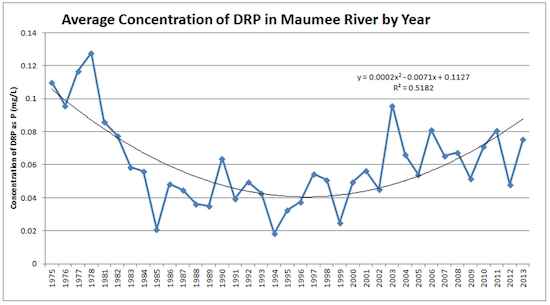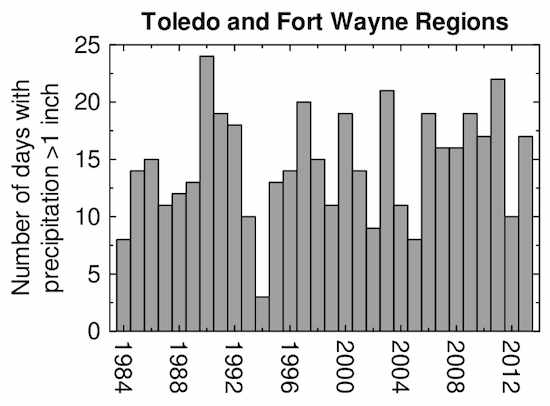By Sierra Rayne ——Bio and Archives--August 7, 2014
Global Warming-Energy-Environment | CFP Comments | Reader Friendly | Subscribe | Email Us
"July 2014 was one of the coldest months of July on record for the Toledo region, Lake Erie's temperature during the last days of the month was well below the historical average and the average lake temperature for the entire month was about average, there are no significant trends towards a hotter July in the area over the past century, and there are no significant trends in Lake Erie's end-of-July or average July temperatures since records began in 1927."At Vox.com, Blad Plumer lauds a purportedly "terrific report" by the website Circle of Blue on the effects of northern Ohio's cropland and land use on the Maumee River and Lake Erie. Two key problems exist in this report. First off, the report shows the following figure -- also reproduced at Vox.com -- of average annual dissolved reactive phosphorus (DRP) concentrations in the Maumee River since 1975.
 Look at the trendline, and then look at the data. The statistically inappropriate trendline shows a massive increase in DRP concentrations over the past decade, but the actual data shows either absolutely no trend -- or more likely a modest decline. DRP concentrations in the river have been higher over the past decade than they were from the mid-1980s through the early-2000s, but there has been no upward trend since 2003. Figures with trendlines this poor should not be reproduced or promoted in the media. They only serve to further dumb down the public's already intolerably low scientific literacy.
The Circle of Blue report also claims that extreme rainfall -- defined as a daily precipitation above one inch -- is increasing in the Maumee River region. The Maumee River forms near Fort Wayne, Indiana and then flows into Lake Erie at Toledo. If climate change was causing an increase in extreme rainfall in this area, and if that increased extreme rainfall from anthropogenic climate change was leading to higher DRP loadings, then we would expect to find a significant increase in the number of monthly and/or annual extreme precipitation events for the region that correlates with high statistical significance to the increase in atmospheric greenhouse gas concentrations. But we do not.
In the Toledo climate region and the Fort Wayne region, there are no significant trends towards increasing numbers of days with greater than one inch of precipitation during the past three decades in any month, nor on an annual basis.
Look at the trendline, and then look at the data. The statistically inappropriate trendline shows a massive increase in DRP concentrations over the past decade, but the actual data shows either absolutely no trend -- or more likely a modest decline. DRP concentrations in the river have been higher over the past decade than they were from the mid-1980s through the early-2000s, but there has been no upward trend since 2003. Figures with trendlines this poor should not be reproduced or promoted in the media. They only serve to further dumb down the public's already intolerably low scientific literacy.
The Circle of Blue report also claims that extreme rainfall -- defined as a daily precipitation above one inch -- is increasing in the Maumee River region. The Maumee River forms near Fort Wayne, Indiana and then flows into Lake Erie at Toledo. If climate change was causing an increase in extreme rainfall in this area, and if that increased extreme rainfall from anthropogenic climate change was leading to higher DRP loadings, then we would expect to find a significant increase in the number of monthly and/or annual extreme precipitation events for the region that correlates with high statistical significance to the increase in atmospheric greenhouse gas concentrations. But we do not.
In the Toledo climate region and the Fort Wayne region, there are no significant trends towards increasing numbers of days with greater than one inch of precipitation during the past three decades in any month, nor on an annual basis.
 There appears to be no relation between the number of these events and corresponding DRP concentrations in the Maumee River.
Nowadays it seems everything gets linked to climate change, but little or no effort is made in the media to examine -- and then clearly demonstrate to the readers -- whether the causation is supported by our climate and other environmental datasets. Far too often, when we look into the matter in detail, it seems there is simply no clear relationship between much of what is going on and the omnipresent anthropogenic climate change bogeyman.
There appears to be no relation between the number of these events and corresponding DRP concentrations in the Maumee River.
Nowadays it seems everything gets linked to climate change, but little or no effort is made in the media to examine -- and then clearly demonstrate to the readers -- whether the causation is supported by our climate and other environmental datasets. Far too often, when we look into the matter in detail, it seems there is simply no clear relationship between much of what is going on and the omnipresent anthropogenic climate change bogeyman.View Comments
Sierra Rayne holds a Ph.D. in Chemistry and writes regularly on environment, energy, and national security topics. He can be found on Twitter at @srayne_ca